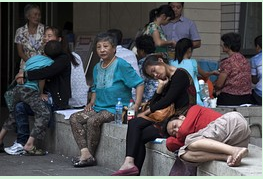
As China's new leaders take up their posts this fall, one of the most critical tasks that faces them will be reforming the country's broken health-care system.
今年秋天中国新一届领导人上任的时候,摆在他们面前最关键的任务之一,将是改革这个国家支离破碎的医疗体系。
The Chinese government has spent $125 billion over the past three years to extend insurance coverage to 95% of the population while also improving access to hospitals and clinics. But despite that effort, the country's health-care system still has a long way to go to and the challenges ahead are mounting, according to a new study from consultancy McKinsey & Co.
中国政府在过去三年投入了1,250亿美元,将医保覆盖范围提高到占全国人口95%的水平,同时改善看病难问题。但咨询公司麦肯锡(McKinsey & Co.)新发表的研究报告显示,中国的医疗体系改革还有很长的路要走,接下来的挑战将越来越严峻。
The report notes that China's health care spending is poised to triple to $1 trillion by 2020 and while the rate of insurance coverage is high, so are the out-of-pocket burdens on consumers. Most of China's insured still don't understand the limits of their coverage plans, which will leave them financially devastated in the case of a catastrophic incident, the report said.
报告指出,到2020年,预计中国的医疗支出将达到1万亿美元,比目前水平高两倍。报告说,虽然医保覆盖率高,居民自缴部分的负担也不轻。报告说,中国很多参保人员仍不了解所缴医保的限制,如果碰到大病,这些限制将使他们陷入财务困境。
Another problem highlighted in the study: a still yawning disparity in quality of health care between rural and urban regions. The country lacks a sufficient national drug supply to ensure that rural patients are provided the same access to pharmaceuticals as their urban counterparts, the study finds. Meanwhile, hospitals in rural areas are hard to reach and lack high-quality equipment and manpower, leaving many to flock to urban centers for care. The result is overrun, already underfunded city hospitals.
报告还强调了另外一个问题:城乡医疗质量差距仍然很大。报告发现,全国药品供应不足,因此无法确保农村病人能像城镇病人一样能够获得药品。与此同时,农村地区就医难,缺乏高质量的设备和人员,所以很多人涌向城市地区看病。这造成缺乏资金的城市医院超负荷运转。
Even relatively well-off Chinese feel health-care facilities are inadequate, with 31% saying it's difficult to access care in public hospitals, according to a McKinsey survey of 1,000 people with annual incomes greater than 80,000 yuan ($12,600).
甚至相对富裕的中国人也觉得医疗设施不足。麦肯锡调查了1,000名年收入超过8万元的人士,31%的人表示在公立医院很难看上病。
A crisis between China's chronically underpaid doctors, who look to pad their low pay checks with kickbacks from pricey drug prescriptions, and skeptical patients is well underway, highlighted by a spiking number patient attacks against physicians, the report said. According to McKinsey's survey of nearly 6,000 physicians in 3,300 hospitals, 59% of doctors said they had been verbally assaulted by a patient or a patient's family member. And 6% said they have been physically assaulted by patients.
长期以来,中国医生工资一直不高,为弥补低工资,他们通过开高价药的方式来赚取回扣。报告说,病人对医生的怀疑情绪与日俱增,病人攻击医生的事例越来越多就是这种矛盾的体现。麦肯锡调查了3,300家医院的近6,000名医生,59%的人表示被患者或患者家属骂过,6%的人表示被患者攻击过。
Recent articles from the Economist and the Associated Press cite mistrust and anger over perceived inadequate treatment as reasons for the assaults.
近期《经济学人》(Economist)和美联社(Associated Press)刊发的文章认为,打骂医生的原因是患者觉得没有得到足够的治疗,因此不信医生,心生怨恨。
Asked if tensions in the relationships with patients had changed in the last year, 44% of respondents in the McKinsey survey said it had worsened and 51% said it remained the same. McKinsey also found that
在被问到过去一年医患矛盾有无变化时,麦肯锡调查中44%的受访者表示矛盾恶化,51%的人表示没有变化。麦肯锡还发现,中国37%的医生表示对自己的工作不满意,5%的人表示正在考虑改行。
37% of doctors in China said they were not satisfied with their work and 5% said they were considering a career change.
如何让这一切得到控制,将是令中国领导人头疼的一件事。这同样也曾是美国总统奥巴马(Barack Obama)等其他国家领导人感到头疼的事情。但麦肯锡提到,虽然有这些艰巨挑战,企业──不管是中国企业还是跨国公司──也将迎来前所未有的机会:从药品到医疗设备,从私立医院到私人医保,所有市场都将扩大。


